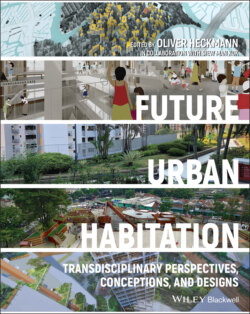Читать книгу Future Urban Habitation - Группа авторов - Страница 11
Inclusive Urbanism
ОглавлениеThe multifaceted aspects of what inclusion‐minded practices should entail have been iterated in critical research, planning guidelines, and frameworks on inclusive design: Independent of one's individual abilities or status, everybody should have equal access nearby to diverse, affordable housing, fair employment, places of consumption, public facilities such as for education or healthcare and other infrastructure. Having a stable home is at the core of both individual and collective liveabilities, necessitating also the abilities to age in place or raise children safely, to mention a few. Beyond the mere provision of safety and affordability, inclusivity must also empower to equal participation in the social, economic, and political opportunities that cities entail.
But while cities might ideally be places bringing together different people, capabilities, classes, backgrounds, expertise, and markets for their mutual benefits, cities and urban habitats emerged increasingly as ‘arsenals of exclusion’ (Armborst et al. 2017), with often systemic policies, practices, and places, that are deliberately instrumental in preventing or even withdrawing equal access to the potentials urbanism entails – by excluding citizens because of their race, income, status, nationality, education, or sexual orientation, to mention a few.
With neoliberalism and the local impacts of global finance, the withdrawal of welfare states as instrument to re‐balance pressing societal inequalities, cities and their habitats are ever more threatened to become conflicted, exclusive territories. The commodification of housing and lack of affordable dwellings as a consequence, the radical impacts of shifts in global production on the socio‐economic fabric in cities, and the complex consequences of global migrations due to climate change or conflicts threaten ever broader groups with the complex uncertainties of exclusion: both those, that would depend even more on the capacity of habitats for their inclusion like vulnerable populations, but increasingly also those that were always considered to be safely integrated within their neighbourhoods.
The authors in this section illustrate alternative ways how future urban territories could be conceptualized to cater to inclusive, empowering and sustainable collective living.
Policymakers and researchers from the Barcelona City Social Rights Department and the Institute for Regional and Metropolitan Studies in Barcelona illustrate their essential role as both innovators and implementors of inclusivity‐driven policies. They share about redesigning services for the care of elderly and the creation of solidarity ties. With the pursuit of ‘integral superblocks’, strategic connections between physical and social aspects are drawn to move towards new social city models.
Sociological perspectives on inclusion in Singapore are raised by Vincent Chua, a sociology professor at National University of Singapore, as a socially diverse city where network segregations occur along domains like education and housing. Given the lack of welfare policies other means for an inclusive society are discussed: voluntarism to enhance social capital, community building based on acceptance of diversity, and joint debates on common frames of reference.
The Social Urban Research Group based at Singapore University of Technology and Design shares about research and initiatives for participatory place‐making and ‐keeping opportunities for marginalized groups, aiming for social integration, community empowerment, and co‐creating processes through both web‐ and site‐based platforms.
Inclusive design strategies for sustainable urban revitalization and local interventions as catalysts for social innovation are presented by the architecture firms LOHA in projects for Detroit and SHAU for Indonesian cities, with both employing integrative roles as designers, researchers, initiators of change, and moderators between numerous agencies. They consider architectural interventions as potential agencies to ‘design coexistence’ contributing to an open city. Based on community workshops and other participatory practices, their projects entail community framework plans, programming initiatives as well as small‐scale interventions, as community‐driven responses to imminent needs and initiatives.
Affordable housing policies are discussed by the sociologist Gerald Koessl from the Austrian Federation of Limited‐Profit Housing Associations, who considers the provision of affordable and secure homes as an important stepping stone to participate in social and economic life. He presents Vienna's limited‐profit housing developers as examples for market models, that are co‐shaped by social and institutional processes and that are sustainable also in the long term because of its revolving funds.
